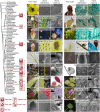The digestive systems of carnivorous plants
- PMID: 35604105
- PMCID: PMC9434158
- DOI: 10.1093/plphys/kiac232
The digestive systems of carnivorous plants
Abstract
To survive in the nutrient-poor habitats, carnivorous plants capture small organisms comprising complex substances not suitable for immediate reuse. The traps of carnivorous plants, which are analogous to the digestive systems of animals, are equipped with mechanisms for the breakdown and absorption of nutrients. Such capabilities have been acquired convergently over the past tens of millions of years in multiple angiosperm lineages by modifying plant-specific organs including leaves. The epidermis of carnivorous trap leaves bears groups of specialized cells called glands, which acquire substances from their prey via digestion and absorption. The digestive glands of carnivorous plants secrete mucilage, pitcher fluids, acids, and proteins, including digestive enzymes. The same (or morphologically distinct) glands then absorb the released compounds via various membrane transport proteins or endocytosis. Thus, these glands function in a manner similar to animal cells that are physiologically important in the digestive system, such as the parietal cells of the stomach and intestinal epithelial cells. Yet, carnivorous plants are equipped with strategies that deal with or incorporate plant-specific features, such as cell walls, epidermal cuticles, and phytohormones. In this review, we provide a systematic perspective on the digestive and absorptive capacity of convergently evolved carnivorous plants, with an emphasis on the forms and functions of glands.
© The Author(s) 2022. Published by Oxford University Press on behalf of American Society of Plant Biologists.
Figures



References
-
- Adlassnig W, Koller-Peroutka M, Bauer S, Koshkin E, Lendl T, Lichtscheidl IK (2012) Endocytotic uptake of nutrients in carnivorous plants. Plant J 71: 303–313 - PubMed
-
- Adlassnig W, Lendl T, Lang I (2010) Deadly glue — adhesive traps of carnivorous plants. InByern V, Grunwald J, eds, Biological Adhesive Systems. Springer, Vienna, Austria, pp 15–28
-
- Adlassnig W, Steinhauser G, Peroutka M, Musilek A, Sterba JH, Lichtscheidl IK, Bichler M (2009) Expanding the menu for carnivorous plants: uptake of potassium, iron and manganese by carnivorous pitcher plants. Appl Radiat Isot 67: 2117–2122 - PubMed
-
- Albert VA, Williams SE, Chase MW (1992) Carnivorous plants: phylogeny and structural evolution. Science 257: 1491–1495 - PubMed
Publication types
MeSH terms
Substances
LinkOut - more resources
Full Text Sources
Miscellaneous

